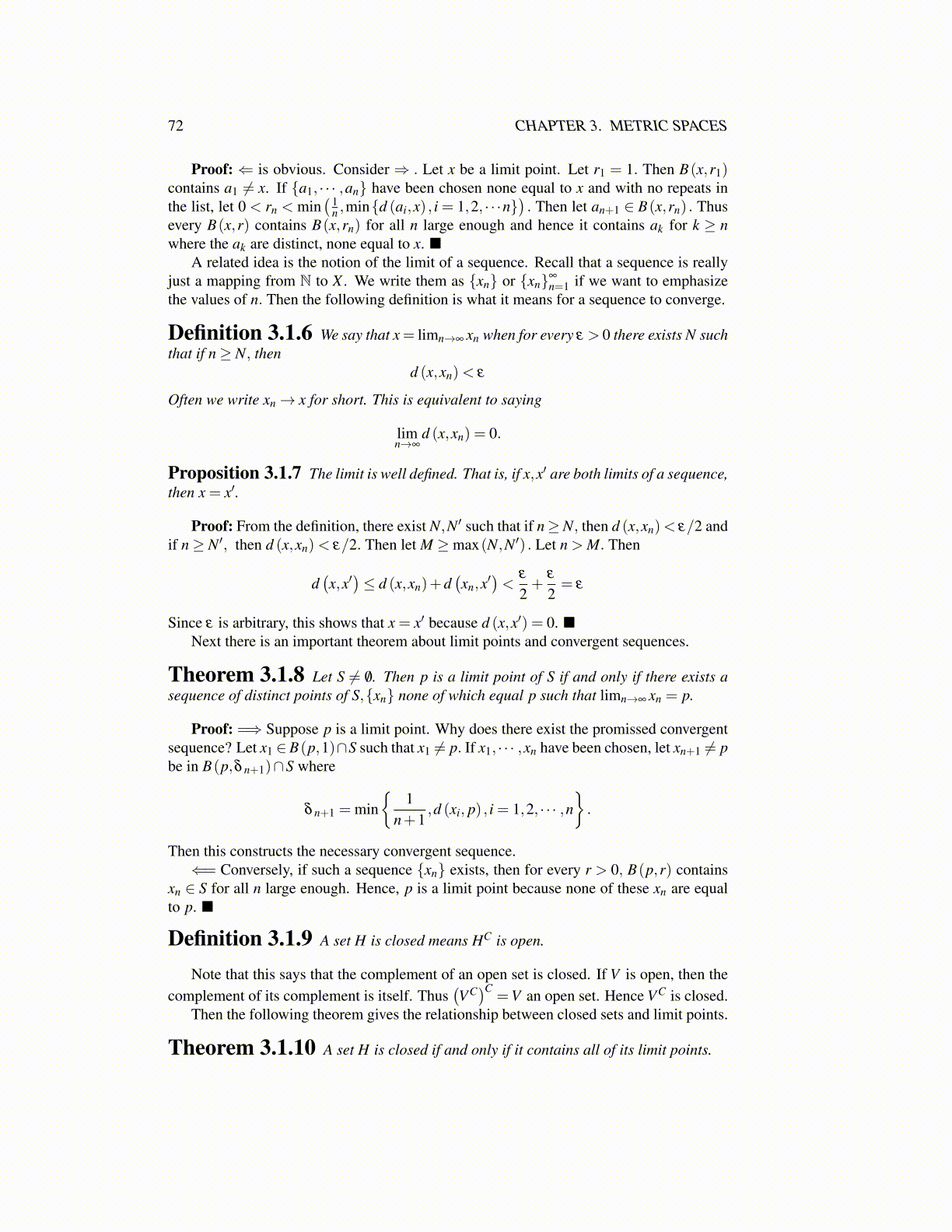
72 CHAPTER 3. METRIC SPACES
Proof: ⇐ is obvious. Consider ⇒ . Let x be a limit point. Let r1 = 1. Then B(x,r1)contains a1 ̸= x. If {a1, · · · ,an} have been chosen none equal to x and with no repeats inthe list, let 0 < rn < min
( 1n ,min{d (ai,x) , i = 1,2, · · ·n}
). Then let an+1 ∈ B(x,rn) . Thus
every B(x,r) contains B(x,rn) for all n large enough and hence it contains ak for k ≥ nwhere the ak are distinct, none equal to x. ■
A related idea is the notion of the limit of a sequence. Recall that a sequence is reallyjust a mapping from N to X . We write them as {xn} or {xn}∞
n=1 if we want to emphasizethe values of n. Then the following definition is what it means for a sequence to converge.
Definition 3.1.6 We say that x= limn→∞ xn when for every ε > 0 there exists N suchthat if n≥ N, then
d (x,xn)< ε
Often we write xn→ x for short. This is equivalent to saying
limn→∞
d (x,xn) = 0.
Proposition 3.1.7 The limit is well defined. That is, if x,x′ are both limits of a sequence,then x = x′.
Proof: From the definition, there exist N,N′ such that if n≥N, then d (x,xn)< ε/2 andif n≥ N′, then d (x,xn)< ε/2. Then let M ≥max(N,N′) . Let n > M. Then
d(x,x′)≤ d (x,xn)+d
(xn,x′
)<
ε
2+
ε
2= ε
Since ε is arbitrary, this shows that x = x′ because d (x,x′) = 0. ■Next there is an important theorem about limit points and convergent sequences.
Theorem 3.1.8 Let S ̸= /0. Then p is a limit point of S if and only if there exists asequence of distinct points of S,{xn} none of which equal p such that limn→∞ xn = p.
Proof: =⇒ Suppose p is a limit point. Why does there exist the promissed convergentsequence? Let x1 ∈B(p,1)∩S such that x1 ̸= p. If x1, · · · ,xn have been chosen, let xn+1 ̸= pbe in B(p,δ n+1)∩S where
δ n+1 = min{
1n+1
,d (xi, p) , i = 1,2, · · · ,n}.
Then this constructs the necessary convergent sequence.⇐= Conversely, if such a sequence {xn} exists, then for every r > 0, B(p,r) contains
xn ∈ S for all n large enough. Hence, p is a limit point because none of these xn are equalto p. ■
Definition 3.1.9 A set H is closed means HC is open.
Note that this says that the complement of an open set is closed. If V is open, then thecomplement of its complement is itself. Thus
(VC)C
=V an open set. Hence VC is closed.Then the following theorem gives the relationship between closed sets and limit points.
Theorem 3.1.10 A set H is closed if and only if it contains all of its limit points.